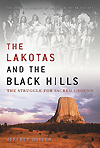
The Lakotas and the Black Hills: The Struggle for Sacred Ground, by Jeffrey Ostler, Viking, New York, 2010, $22.95
In 1857, almost two decades before prospectors began staking claims in the Black Hills, between 5,000 and 10,000 Lakotas gathered on the Belle Fourche River near Bear Butte. On the agenda was how to keep whites off their land. One desperate but prescient strategy, later related by the Hunkpapa Black Moon, was to declare that “any Indian who should show the goldfields in the Black Hills to the white man should die.” The Lakotas could not keep the whites from discovering gold, but the 1857 council did mark the beginning of a long struggle to retain and, after 1877, regain the Black Hills, the center of Lakota cosmology. Jeffrey Ostler eloquently relates this ongoing process in The Lakotas and the Black Hills.
Ostler’s narrative continues past what many view as the last gasp of Lakota resistance—Wounded Knee—and reveals a strong continuity between 19th- and 20th-century diplomatic efforts. The Lakotas have, for instance, always stressed to federal authorities the great value they place on the Black Hills. In the 1875 Allison Commission talks on the White River in northwestern Nebraska, the treaty bands outright rejected the government’s offer of $6 million for the Black Hills and demanded the president support them “for seven generations ahead,” meaning forever. In 1920 when Congress allowed the Lakotas to sue for damages with the U.S. Court of Claims, affidavits compiled from older tribesmen swore, over and over, that the government’s promise as they understood it was to provide annuities “so long as the world lasts and there is an Indian living.”
Ostler notes that though an 1878 delegation to Washington, D.C., did of necessity agree to relinquish the Black Hills (later Lakotas rejected their right to do so), the delegates were able to counter government proposals to relocate their reservation either to Indian Territory or to the banks of the smallpox-ridden Missouri River. This would have seriously jeopardized tribal sovereignty and indeed the Lakotas’ very existence.
Ostler is sympathetic to the Lakotas’ case for reclaiming the Black Hills, disputing scholars who argue that the land was not sacred to the tribe in the 19th century. He conveys the central position of the Black Hills in Lakota origin stories and cites 19th-century explorers’ journals that describe the tribe’s deep-rooted spiritual connection to the land. But he does not make a strong case for a Lakota presence in the region before the late 1700s, nor does he address the issue of hypocrisy with regard to the Lakotas’ own conquest of the land.
A landmark 1980 Supreme Court case awarded the Lakotas $102 million for the Black Hills. Tribal leaders immediately rejected the settlement, fearing it would undermine efforts to regain the land. It seems unlikely a social climate will ever exist favorable to returning the Black Hills to the Lakotas. But as Ostler shows, the Lakotas will continue the fight.
—Stephen Mauro




